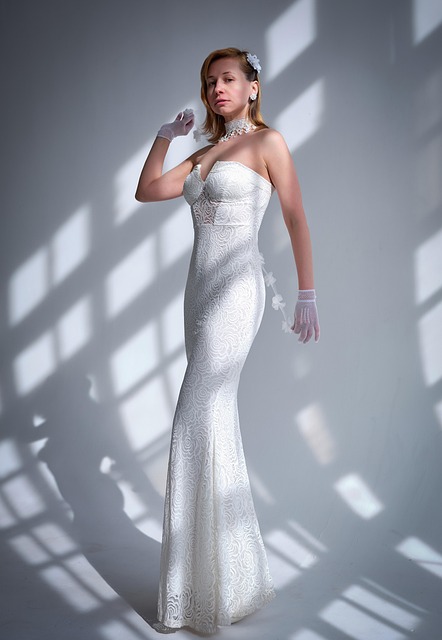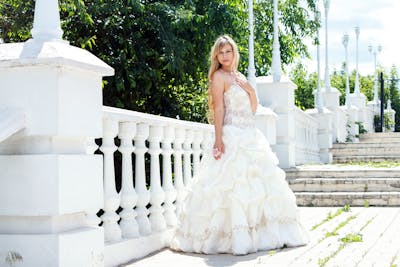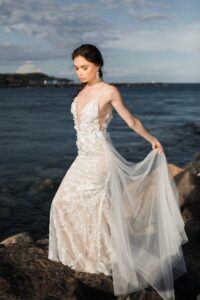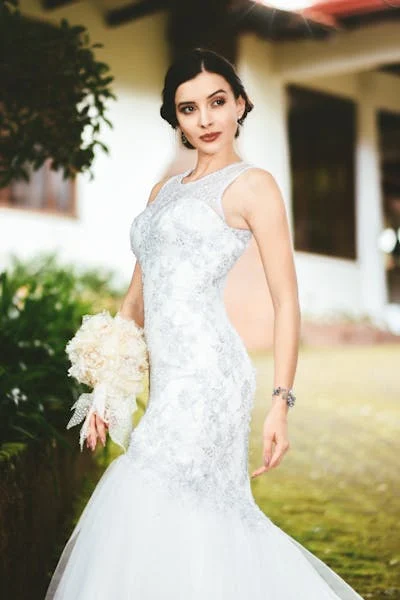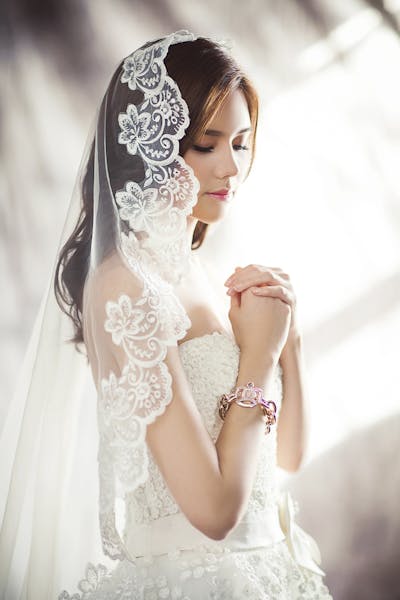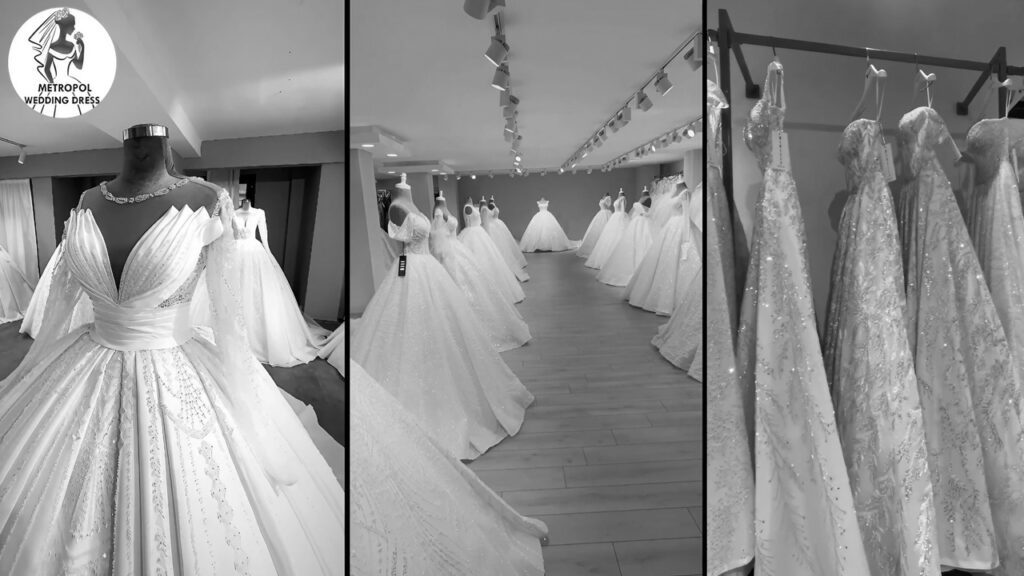
Challenges of Buying Bulk Wedding Gowns While bulk purchasing offers many benefits, it also comes with challenges. Being aware of these potential pitfalls can help retailers make informed decisions and mitigate risks.
The wedding gown market is evolving rapidly. Traditional bridal boutiques, e-commerce startups, and wholesalers alike are discovering the enormous potential in bulk wedding gown purchasing. With wholesale prices allowing for larger profit margins and retail perfection as the end goal, this model has become a game-changer in the bridal fashion industry.
From affordability to variety, this guide dives deep into the world of bulk wedding gowns, showcasing how businesses and fashion entrepreneurs can leverage this opportunity to thrive in a competitive market.
Quality Control Issues
Not all suppliers maintain consistent quality across large orders. Poorly made gowns can lead to customer complaints and damage a retailer’s reputation. To avoid this, request samples, establish clear quality standards, and conduct regular inspections.
Inventory Management Challenges
Buying in bulk requires adequate storage space and effective inventory management systems. Overstocking can tie up capital, while understocking can lead to missed sales. Retailers should invest in inventory tracking tools and forecast demand based on seasonal trends.
Shipping and Logistics Delays
International shipping can be unpredictable, with delays caused by customs, weather, or logistical issues. Retailers should plan ahead, order well in advance of peak seasons, and work with suppliers who offer reliable shipping partners.
Challenges of Buying Bulk Wedding Gowns
Brides have high expectations for their wedding gowns particularly in terms of fit, quality, and design. Retailers must ensure that gowns meet these standards to avoid returns, negative reviews, and reputational damage.
Currency and Pricing Fluctuations
When sourcing gowns internationally, currency fluctuations and unexpected price changes can impact costs. Retailers should negotiate fixed pricing where possible and monitor exchange rates to manage expenses.
Tips for Retailers Selling Bulk Wedding Gowns
To achieve retail perfection, retailers should focus on customer satisfaction, marketing, and operational efficiency. Below are practical tips to succeed in the competitive bridal market.
Prioritize Exceptional Customer Service
Offer personalized support, such as virtual consultations, sizing guides, and flexible return policies. Exceptional customer service builds trust, encourages repeat business, and fosters positive reviews.
Invest in Professional Photography
High-quality images showcase the elegance and craftsmanship of your gowns, attracting customers. Use multiple angles, close-ups of details, and lifestyle shots to highlight each gown’s unique features.
Create a User-Friendly Website
Ensure your website is mobile-friendly, easy to navigate, and optimized for conversions. Include clear calls-to-action, such as “Shop Now” or “Request a Quote,” to guide customers through the purchasing process.
Stay Ahead of Bridal Trends
Monitor bridal fashion trends and update your inventory regularly to offer the latest styles. Subscribe to industry publications, follow designers on social media, and attend trade shows to stay informed.
Partner with Wedding Planners and Venues
Collaborate with wedding planners, venues, and event coordinators to promote your gowns. Offering exclusive discounts or referral incentives can help you tap into their client networks and boost sales.
Offer Promotions and Discounts
Use seasonal promotions, bundle offers, or loyalty discounts to attract customers. These strategies can drive sales, clear excess inventory, and appeal to price-sensitive brides.
The Future of Bulk Wedding Gowns
The wholesale wedding gown industry is poised for growth, driven by technological advancements, changing consumer preferences, and global market trends. Below are key developments shaping the future of this sector.
Rise of E-Commerce
Online retail is transforming the bridal industry, with more brides shopping for gowns online. Retailers with robust e-commerce platforms, global shipping capabilities, and seamless user experiences will dominate the market.
Advancements in Technology
Technologies like virtual try-on tools, 3D visualization, and AI-driven design platforms are enhancing the online shopping experience. Retailers can leverage these tools to help brides visualize gowns before purchasing, reducing returns and increasing satisfaction.
Growing Emphasis on Sustainability
As sustainability becomes a core consumer value, suppliers and retailers must prioritize eco-friendly practices. Offering gowns made from sustainable materials and promoting ethical production will resonate with environmentally conscious brides.
Expansion of Inclusive Offerings
The demand for inclusive sizing and culturally diverse designs is growing. Suppliers who provide a wide range of sizes, styles, and cultural inspirations will attract a global audience, helping retailers cater to diverse markets.
Personalization and Customization
Brides increasingly seek personalized gowns that reflect their unique style. Suppliers offering customization options, such as tailored sizing or bespoke embellishments, will give retailers a competitive edge.
Case Studies: Success Stories in Bulk Wedding Gown Retail
Boutique Success Through Strategic Sourcing
A small bridal boutique in California partnered with a Chinese supplier on Alibaba to source bulk wedding gowns at wholesale prices. By focusing on sustainable and bohemian designs, the boutique attracted eco-conscious brides and tripled its revenue within 18 months.
A wedding dress is more than just a piece of clothing—it’s a symbol of love, celebration, and dreams coming true. For many brides, it’s the most important outfit they will ever wear. Whether you’re drawn to timeless elegance, modern minimalism, or whimsical romance, finding the perfect wedding dress is a journey filled with excitement, emotion, and discovery.
1. A Brief History of the Wedding Dress
The white wedding dress became popular thanks to Queen Victoria, who wore a white gown for her wedding to Prince Albert in 1840. Before that, brides wore their best dresses—regardless of color. Since then, the wedding gown has evolved across cultures and decades, reflecting social trends, economic changes, and fashion innovation.
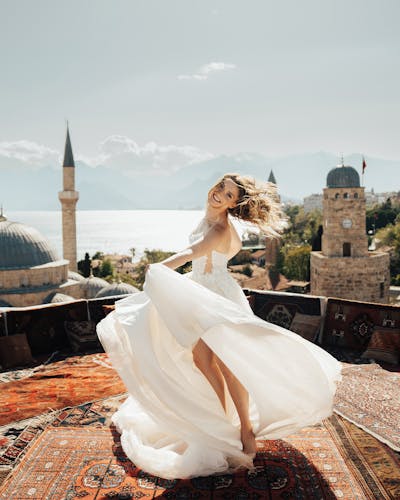
2. Popular Wedding Dress Styles
Choosing a wedding dress starts with understanding the main silhouettes and necklines available. Here’s a breakdown:
2.1 Silhouettes
- A-Line: Universally flattering and easy to move in.
- Ball Gown: Classic fairytale style with a fitted bodice and full skirt.
- Mermaid: Highlights curves and offers a dramatic flair.
- Sheath: Sleek and minimal; perfect for modern brides.
- Empire Waist: High waistline under the bust; great for a romantic, flowy look.
2.2 Necklines
- Sweetheart: Heart-shaped, soft, and feminine.
- V-Neck: Elegant and elongates the neck.
- Halter: Modern and great for showcasing shoulders.
- Off-the-Shoulder: Romantic and classic.
- Bateau (Boat Neck): Graceful and modest.
3. Choosing the Right Fabric
Fabric plays a major role in the overall look and feel of a wedding dress. Here are the most common options:
- Tulle: Light, airy, perfect for ball gowns.
- Lace: Elegant, detailed, and timeless.
- Satin: Smooth and glossy, great for structured gowns.
- Chiffon: Flowy and lightweight—ideal for beach weddings.
- Organza: Crisp and more structured than chiffon.
4. Wedding Dresses for Every Body Type
Finding the perfect gown is all about fit and confidence. Here’s a simple guide:
- Petite Brides: Try sheath or A-line styles to elongate the figure.
- Curvy Brides: Mermaid, trumpet, or structured A-lines enhance curves beautifully.
- Tall Brides: You can pull off dramatic silhouettes like ball gowns.
- Athletic Body: Halter or sweetheart necklines create softness and shape.
5. Wedding Dress Shopping Tips
Start Early
Begin shopping at least 8-12 months before your wedding to allow time for ordering, fittings, and alterations.
Set a Budget
Wedding dresses range from $300 to $10,000+. Decide on a budget that includes accessories and tailoring.
Keep an Open Mind
The dress you fall in love with might not be what you imagined. Try on different styles to find your best fit.
Bring Supportive People
Limit your entourage to a few trusted voices to avoid overwhelm.
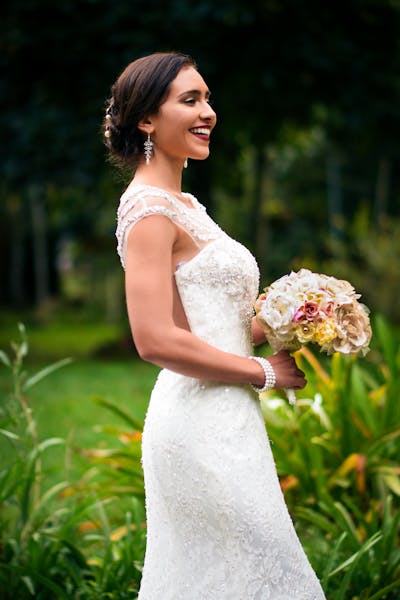
6. Trends in Wedding Dresses (2025)
Every year brings fresh styles. Here’s what’s trending now:
- Detachable sleeves and capes
- Square necklines
- Colored dresses (blush, champagne, light blue)
- Sustainable fabrics
- Two-piece bridal sets
7. Alternative Wedding Dress Options
Not every bride wants traditional. Here are creative alternatives:
- Jumpsuits or pantsuits
- Short wedding dresses
- Boho styles for outdoor weddings
- Cultural wedding gowns (like hanbok, sari, or qipao)
8. Where to Buy Wedding Dresses
Bridal Boutiques
Offer personalized service, fittings, and a curated selection.
Online Retailers
Websites like ASOS, BHLDN, Lulus, and Etsy offer beautiful gowns at various price points.
Second-Hand and Vintage Shops
Eco-friendly and budget-conscious options with lots of character.
Wholesale and Custom Designers
Perfect for brides who want unique, tailored styles—especially for destination weddings or specific themes.
9. Accessories to Complete the Look
- Veil or Headpiece
- Jewelry
- Shoes (heels, flats, or barefoot sandals)
- Clutch or purse
- Shapewear or undergarments
Conclusion: The Dress, The Moment, The Memory
Choosing a wedding dress is one of the most personal and joyful parts of wedding planning. Whether you go traditional or unconventional, the perfect gown is the one that makes you feel confident, radiant, and ready to say “I do.”
Popular wedding dress styles in 2025 reflect a blend of timeless elegance, modern minimalism, and bold individuality, catering to diverse tastes and body types. Based on current trends, here are the key styles:
- A-Line: Universally flattering, this style cinches at the waist and flares out into a subtle “A” shape. It suits most body types, offering a classic, romantic look with versatility for various fabrics like lace or satin.
- Ball Gown: Ideal for fairy-tale vibes, ball gowns feature fitted bodices and voluminous, floor-length skirts. They’re perfect for dramatic entrances and suit pear-shaped or slender figures, often adorned with tulle or intricate embroidery.
- Mermaid/Trumpet: These fitted gowns hug the body through the hips and flare out at the knees (mermaid) or mid-thigh (trumpet). They emphasize curves, ideal for hourglass figures, and often include luxurious details like lace appliqués or beading.
- Sheath: Sleek and simple, sheath dresses follow the body’s natural shape without heavy embellishments. They’re great for minimalist brides or beach weddings, suiting petite or athletic builds with lightweight fabrics like chiffon or crepe.
- Slip Dress: A 90s-inspired, straight-cut style with a relaxed, lingerie-like aesthetic. Perfect for modern, understated brides, slip dresses in silk or satin work well for slim or straight figures and casual settings.
- Bohemian (Boho): Flowy, relaxed, and nature-inspired, boho dresses feature soft fabrics like lace and crochet, often with bell sleeves or off-shoulder designs. They suit free-spirited brides and outdoor venues, flattering most body types.
- Tea-Length/Midi: These dresses, ending between the knee and ankle, offer a vintage or playful vibe. They’re ideal for retro-inspired weddings or petite brides, often paired with fun accessories like colorful shoes.
- High-Low: Featuring a shorter front and longer back, high-low dresses combine drama with practicality. They’re great for showing off statement shoes and suit outdoor or casual weddings, flattering most figures.
Trends for 2025:
- Sleeves and Detachable Elements: Long sleeves, puffed sleeves, or detachable trains and overskirts add versatility.
- Bold Details: Corset bodices, dramatic bows, and 3D floral appliqués are trending for statement-making looks.
- Non-Traditional Colors: Soft pastels, champagne, or even black dresses are gaining popularity for unique brides.
- Sustainability: Eco-friendly fabrics like organic cotton or recycled materials are on the rise.
Each style can be tailored to personal taste with customizations like neckline (sweetheart, V-neck, off-shoulder) or fabric choice. Consider your venue, body type, and personal aesthetic when choosing. If you’d like, I can search for specific designers or real-time trends on X or the web for more inspiration.
Choosing the right fabric for a wedding dress is crucial for comfort, style, and suitability to the venue, season, and overall aesthetic. Here’s a guide to popular wedding dress fabrics, their characteristics, and how to select the best one:
Common Wedding Dress Fabrics
- Satin:
- Characteristics: Smooth, shiny surface with a luxurious sheen; medium to heavy weight; structured yet soft.
- Best For: Classic, elegant looks like ball gowns or A-line dresses; winter or indoor weddings.
- Pros: Drapes beautifully, holds shape well, timeless appeal.
- Cons: Can feel heavy, may show sweat stains, less breathable for hot weather.
- Best Styles: Ball gown, mermaid, A-line.
- Chiffon:
- Characteristics: Lightweight, sheer, and flowy with a soft, airy texture.
- Best For: Boho or beach weddings; warm-weather or outdoor settings.
- Pros: Breathable, romantic, ideal for layered or draped designs.
- Cons: Delicate, prone to snagging, less structured.
- Best Styles: Sheath, bohemian, empire waist.
- Lace:
- Characteristics: Intricate, open-weave fabric with floral or geometric patterns; varies from delicate to structured.
- Best For: Vintage, romantic, or boho aesthetics; suitable for all seasons depending on weight.
- Pros: Timeless, adds texture, versatile as an overlay or accent.
- Cons: Can be pricey, delicate, may snag.
- Best Styles: A-line, mermaid, bohemian.
- Tulle:
- Characteristics: Lightweight, net-like fabric that’s soft and voluminous; creates a fairy-tale effect.
- Best For: Dramatic ball gowns or layered skirts; spring or summer weddings.
- Pros: Adds volume without weight, dreamy aesthetic, budget-friendly.
- Cons: Can tear easily, less structured unless layered.
- Best Styles: Ball gown, A-line.
- Crepe:
- Characteristics: Smooth, slightly textured fabric with a subtle sheen; lightweight to medium weight.
- Best For: Modern, minimalist looks; warm or indoor settings.
- Pros: Flattering drape, comfortable, wrinkle-resistant.
- Cons: Less ornate, may cling to the body.
- Best Styles: Sheath, slip dress, mermaid.
- Organza:
- Characteristics: Sheer, crisp, and lightweight with a structured feel; slightly stiffer than chiffon.
- Best For: Structured yet ethereal looks; spring or summer weddings.
- Pros: Holds shape well, adds subtle volume, elegant sheen.
- Cons: Can wrinkle, less soft against skin.
- Best Styles: Ball gown, A-line.
- Silk:
- Characteristics: Luxurious, smooth, and lightweight with a natural sheen; includes variations like silk charmeuse or silk dupioni.
- Best For: High-end, sophisticated gowns; all seasons depending on weight.
- Pros: Soft, breathable, elegant drape, eco-friendly option.
- Cons: Expensive, delicate, prone to wrinkles or stains.
- Best Styles: Slip dress, sheath, A-line.
- Mikado:
- Characteristics: Thick, structured silk blend with a subtle shine; heavier and more architectural.
- Best For: Modern, sculptural gowns; fall or winter weddings.
- Pros: Holds bold shapes, wrinkle-resistant, luxurious feel.
- Cons: Heavy, less breathable, can feel stiff.
- Best Styles: Ball gown, mermaid, A-line.
Factors to Consider When Choosing a Fabric
- Season and Climate:
- Warm Weather (Spring/Summer): Opt for lightweight, breathable fabrics like chiffon, tulle, or lightweight lace to stay cool.
- Cool Weather (Fall/Winter): Choose heavier, structured fabrics like satin, mikado, or velvet for warmth and elegance.
- Outdoor Venues: Flowy fabrics like chiffon or tulle suit breezy settings; avoid heavy fabrics that may drag or overheat.
- Dress Style and Silhouette:
- Structured silhouettes (ball gown, mermaid) pair well with satin, mikado, or organza to hold shape.
- Flowy or soft silhouettes (sheath, bohemian) work best with chiffon, crepe, or lightweight lace for a relaxed look.
- Fabrics like lace or tulle can add texture to simpler silhouettes like A-line or slip dresses.
- Comfort and Mobility:
- Prioritize breathability (e.g., chiffon, silk) if you’ll be dancing or moving a lot.
- Lightweight fabrics like crepe or tulle are easier to wear for long hours compared to heavy satin or mikado.
- Body Type:
- Curvy Figures: Satin or crepe can smooth and flatter curves, while lace overlays add elegance without bulk.
- Petite Figures: Lightweight fabrics like chiffon or tulle avoid overwhelming the frame; avoid overly heavy mikado.
- Tall Figures: Structured fabrics like organza or mikado complement height, creating bold, balanced looks.
- Venue and Aesthetic:
- Formal/Indoor (Ballroom, Cathedral): Luxurious, structured fabrics like satin, mikado, or silk elevate the grandeur.
- Casual/Outdoor (Beach, Garden): Flowy, natural fabrics like chiffon, lace, or cotton blends suit relaxed vibes.
- Vintage/Boho: Lace, crochet, or soft tulle enhance romantic, nostalgic aesthetics.
- Budget:
- Affordable options include tulle, chiffon, or synthetic blends that mimic pricier fabrics.
- High-end fabrics like silk or hand-embroidered lace increase costs but offer unmatched quality.
- Sustainability:
- Eco-conscious brides can choose organic cotton, recycled polyester blends, or sustainably sourced silk.
- Look for designers prioritizing ethical production or second-hand dresses to reduce environmental impact.
Additional Tips
- Layering: Combine fabrics (e.g., lace over satin, tulle over chiffon) for texture and depth without sacrificing comfort.
- Test Movement: Try sitting, walking, and dancing in the fabric to ensure it feels good throughout the day.
- Maintenance: Consider care requirements—delicate fabrics like silk or lace may need professional cleaning, while crepe or mikado are more durable.
- Consult Your Designer: If custom-making or altering a dress, ask for fabric swatches to see how they look and feel in person.
If you have a specific dress style, venue, or season in mind, I can recommend the best fabrics to match. I can also search X or the web for real-time examples of dresses in these fabrics or connect you with sustainable fabric options.

